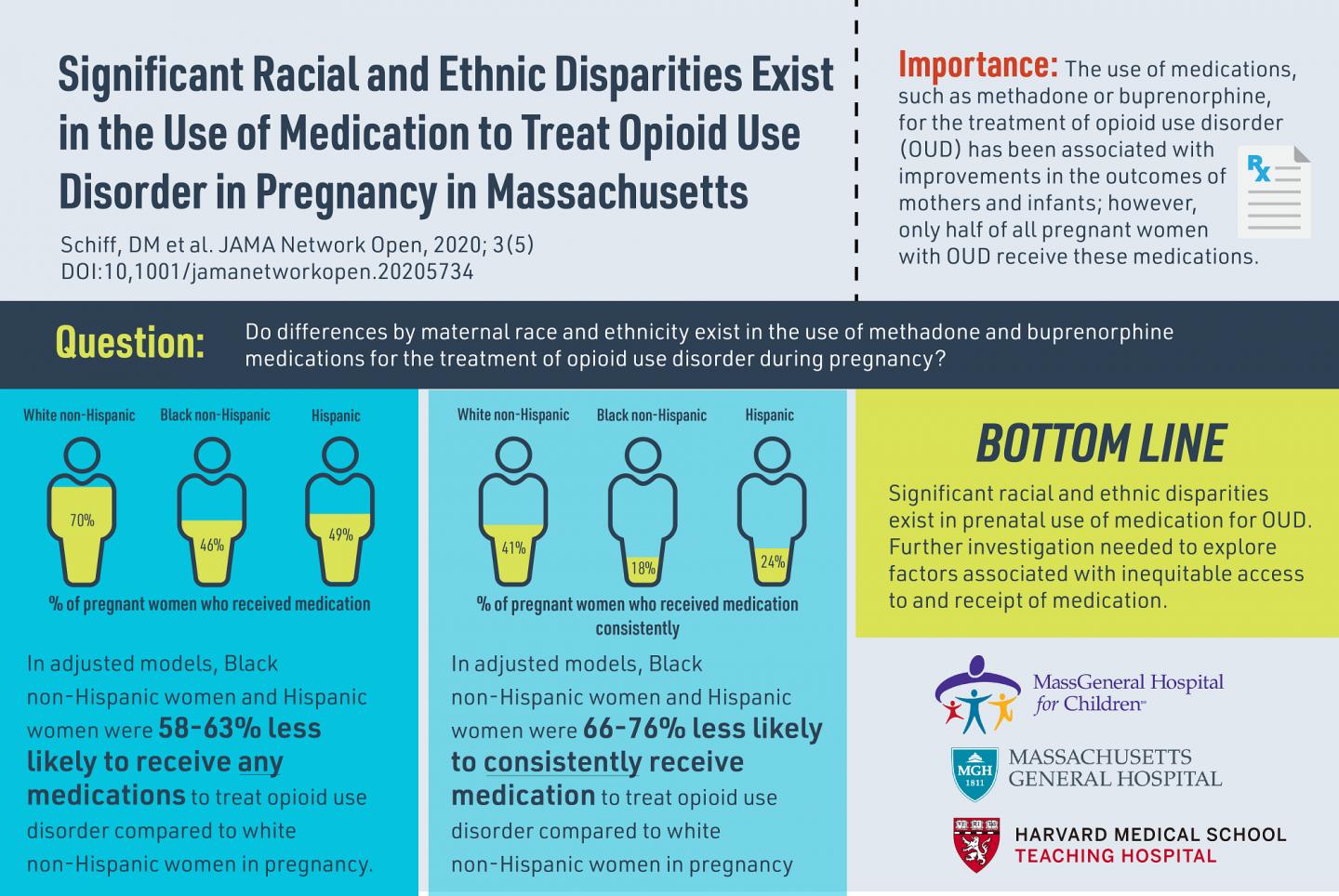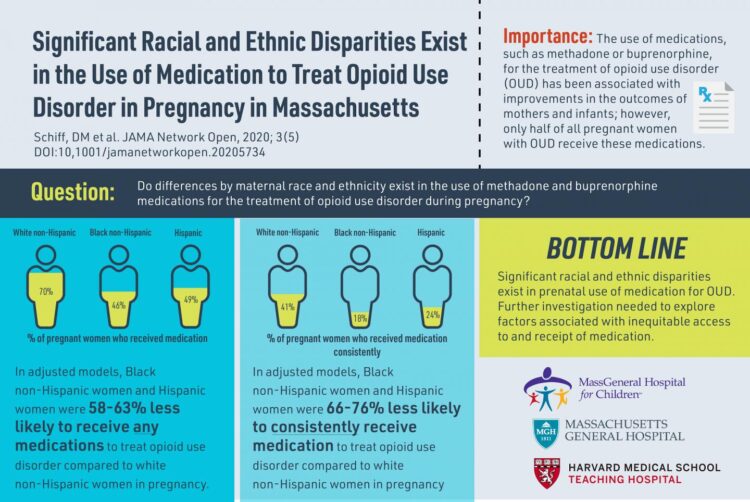
Credit: Davida Schiff, MD — Massachusetts General Hospital
Black non-Hispanic and Hispanic women with opioid use disorder (OUD) are significantly less likely to receive or to consistently use any medication to treat their opioid use disorder during pregnancy than their white non-Hispanic counterparts, according to a new study from Massachusetts General Hospital (MGH).
Based on a population-level sample of women with OUD in the State of Massachusetts, the researchers found racial and ethnic disparities in the range of 60 to 75 percent, despite the fact use of the medications such as methadone and buprenorphine is associated with improvement in outcomes of both mothers and infants.
“We found evidence of striking racial and ethnic differences in terms of medication receipt, continuation of medication use, and type of medication received by pregnant women with OUD,” said Davida Schiff, MD, with the Division of General Academic Pediatrics, MassGeneral Hospital for Children, and lead author of the study, published in JAMA Network Open.
These findings have important implications for our healthcare system as opioid use disorder has increased four-fold over the past decade in the United States, mirroring the increased use of opioids in the general population.
The retrospective study by led by the MGH team and collaborators at the Massachusetts Department of Public Health is the first to explore racial/ethnic differences in the use of medication for OUD during pregnancy. Researchers examined a statewide cohort of more than 5,200 pregnant women with OUD from 2011 to 2015 (87 percent were white non-Hispanic).
They found that black women were 63 percent less likely and Hispanic women 58 percent less likely than white women to receive methadone (dispensed only in federally regulated methadone clinics) or buprenorphine (most commonly prescribed by physicians in office-based settings) for OUD while pregnant, after adjusting for other maternal characteristics.
Those disparities were even greater among women less than 25 years of age. The study further revealed that black non-Hispanic women were 76 percent less likely and Hispanic women 66 percent less likely than white non-Hispanic women to receive consistent treatment for more than six months prior to delivery.
Dr. Monica Bharel, MD, MPH, Commissioner of the Massachusetts Department of Public Health (DPH) and co-author of the study, remarked that “data from our innovative Public Health Data Warehouse has enabled us to gain a deeper understanding of the opioid crisis and document inequities in treatment during pregnancy. This collaboration is an example of our data-driven approach to better understand the treatment experience for women of color and to improve outcomes for women and children.”
During pregnancy, medication along with behavioral therapy is recommended for the management for women with opioid use disorder. This regimen has been proven effective in adherence to prenatal care and in pregnancy outcomes, including lower rates of preterm birth and low birth weight, and reductions in maternal relapse and overdose.
And while pregnancy provides a motivational opportunity for women with OUD to initiate treatment and increase their engagement with health care services, the MGH study suggests that for all women, consistent use of medications during pregnancy in the second and third trimesters was low, at only 38 percent.
Yet for women of color, the rates were significantly lower. Deterrents may include increasingly punitive public policy toward pregnant women who use drugs, racial discrimination by clinicians, cultural differences around medication use, perceived stigma of drug use during pregnancy, and minimal social supports.
“Even in a state like Massachusetts which has a well-funded addiction treatment system and universal insurance coverage in pregnancy, we identified significant racial and ethnic disparities, suggesting that individual and systemic factors are discouraging women from receiving addiction treatment,” says Schiff, a pediatrician and medical director of the HOPE Clinic at MGH that cares for women and families with substance use disorders.
“More than half of all states, including Massachusetts, have either punitive policies toward women who use drugs during pregnancy and/or mandatory reporting of their cases to child protective services, including women who receive medication treatment for OUD. These policies, which disproportionately affect communities of color, are a deterrent to engaging in care. We must replace them with a public health approach that provides resources and true support to all women impacted by substance use disorder.”
###
Lead author Schiff is assistant professor of Pediatrics at Harvard Medical School. Bharel is commissioner of the Massachusetts Department of Public Health (DPH), and co-author of the study. Other DPH collaborators include Dana Bernson, MPH, Hafsatou Diop, MD, MPH, and Sabrina Selk, ScD. MGH co-authors include Elsie Taveras, MD, MPH, Bettina Hoeppner, PhD, John Kelly, PhD, and Timothy Wilens, MD. Additional co-authors include Timothy Nielsen, MPH, at the University of Sydney, Australia, Mishka Terplan, MD, MPH at the Friends Institute, Helena Hansen, MD, PhD at New York University, and Elizabeth E. Krans, MD, MSc at the University of Pittsburgh.
Article cited: Schiff DM, Nielsen T, Hoeppner BB, et al. Assessment of Racial and Ethnic Disparities in the Use of Medication to Treat Opioid Use Disorder Among Pregnant Women in Massachusetts. JAMA Netw Open. 2020;3(5):e205734.
Funding: This study was supported by grants K12 DA043490 and K23DA048169 from the National Institute on Drug Abuse (Dr Schiff), grant 1U38OT000143-04 from the Applied Epidemiology Fellowship Program administered by the Council of State and Territorial Epidemiologists and funded by the Centers for Disease Control and Prevention (Mr Nielsen), grant K24AA022136 from the National Institute on Alcohol Abuse and Alcoholism (Dr Kelly), and grant K24 DK105989 from the National Institute of Diabetes and Digestive and Kidney Diseases (Dr Taveras).
About Massachusetts General Hospital
Massachusetts General Hospital, founded in 1811, is the original and largest teaching hospital of Harvard Medical School. The MGH Research Institute conducts the largest hospital-based research program in the nation, with annual research operations of over $1B and comprises more than 9,500 researchers working across more than 30 institutes, centers and departments. In August 2019 the MGH was once again named #2 in the nation by U.S. News & World Report in its list of “America’s Best Hospitals.
Media Contact
McKenzie Ridings
[email protected]
Original Source
https:/
Related Journal Article
http://dx.





